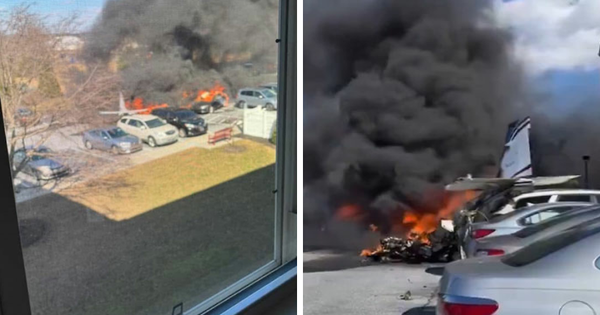
By the time Chaunceey Chery turned 18, he had moved nearly two dozen times.
For years, he bounced between apartments and hotel rooms in Vermont and Florida as his mother struggled with substance abuse.
As a teenager, Chery tried out online school to maintain continuity amid the many moves, but family turmoil and his own mental health challenges prevented him from fully engaging. For nearly two years, he hardly learned anything, he said.
At 15, he began living with relatives in north-eastern Vermont, hoping for more stability. He began regularly attending school in an alternative program meant for students facing adverse circumstances and was able to land a job, but he felt he was “walking on eggshells” living in a space that was not his own. Meanwhile, his housing nightmare continued as one aunt got evicted, another had landlord difficulties and his uncle’s house got foreclosed.
“I felt like I was quadruple homeless at that point,” he said.
Circumstances like what Chery endured as a young person trying to survive and stay in school threaten to become increasingly common in rural areas, as experts warn of a looming affordable housing crisis in remote towns and villages.
In St Johnsbury, Vermont, where Chery lives, the school district’s homeless liaison, Kara Lufkin, said her caseload has jumped to nearly two dozen students this school year after hovering just above a dozen for the two years prior. Lori Robinson, the liaison for another school district in what’s known as Vermont’s north-east kingdom – several counties in the state’s remote north-east corner – also said she’s now serving her highest number of students since starting the role in 2020, when a nationwide eviction moratorium protected families.
Federal funding for low-cost rural rentals has been slashed in recent decades. A US Department of Agriculture program that once helped finance the construction of new apartments in sparsely populated areas of the country has been cut by 95% – squeezing an option long relied upon by many rural households.
But local factors also play in, as Vermont phases out its pandemic rental assistance program. Rebecca Lewis, regional director of the nonprofit Northeast Kingdom Community Action, said her organization is bracing for “a lot more” families to lose their housing in the next six months.
Vermont has the second-highest per capita rate of homelessness in the nation, lower only than California’s, according to a December 2022 report from the US department of housing and urban development. At the same time, the Green Mountain state provides temporary shelter to a higher share of its unhoused residents than any other state, with 98% safely indoors on a point-in-time count from last year.
While dwarfed in size by places like New York City, where the number of homeless students exceeds 100,000, rural students who are unhoused face unique challenges. Emergency shelters, public transportation and cell reception tend to be scarce or nonexistent. Quiet places to work like libraries and coffee shops may be miles away. And in far north regions like St Johnsbury, one winter night without proper shelter can be lethal.

As a homeless liaison, Lufkin understands it’s her job to mitigate these difficulties as much as possible. She coordinates transportation to and from school when families need it and often provides youth in need of winter gear with jackets, hats and gloves. Still, much remains beyond her control.
“[Students] may not be sleeping as well if they’re sleeping on a couch,” she said. “If you’re hungry, your focus isn’t on reading that textbook or doing that math work.”
These are just a few of the many factors that explain why youth who are unhoused have worse education outcomes than any other peer group, with the lowest overall attendance, standardized test scores and high school graduation rates of all students. The limited data that exist suggest roughly the same share of youth in rural areas experience homelessness as in urban areas, but with far less of a support system.
For Chery, a level of stability finally came when, at 18, he entered a temporary housing program for homeless youth run by Northeast Kingdom Youth Services. He finally had a space to himself without worrying about eviction.
“It felt like I could breathe for a second,” he said.
He began taking courses at the local community college, which conveniently was walking distance from where he was staying. He applied to nearby Northern Vermont University for the spring term and was accepted, attending school there for three months until the Covid-19 school shutdowns of March 2020 derailed his plans.
Squeezed out by a housing crunch
For Elysia Gingras, the spiral into homelessness didn’t come until she was in her 30s with five children, who now range in age from 9 to 13.
The once financially comfortable seven-member family now stays in two rooms at an inn in St Johnsbury as a part of Northeast Kingdom Community Action’s supportive housing program.The family’s savings was quickly depleted, the mother said, after a health inspector condemned their apartment of five years, forcing them to crash at a nearby Comfort Inn – a move they thought would last a couple of weeks, tops.
Now two years and hundreds of unsuccessful rental applications later, Gingras has come to understand just how tough the area’s housing market is. Even with her husband working full time as a roofer making over $20 an hour and her selling cosmetics part-time, nothing has panned out yet.
“I look [for rentals] every day and I’m not exaggerating,” Gingras said.
“Every place that we thought we were gonna get, it was like this constant rollercoaster of getting your hopes up and finding out, nope, we didn’t get that one.”
Low-priced housing units in the northeast kingdom have been in short supply for years, explained Patrick Shattuck. He works as executive director of Rural Edge, the region’s main affordable housing development organization and its largest landlord. The kingdom’s population of roughly 65,000 is both shrinking and aging, he said, meaning big houses that used to be occupied by young families now often hold just one or two elderly inhabitants.
At the same time, the rise of seasonal tourism – skiers in the winter and mountain bikers in the summer – have led some property owners to convert rental units into more lucrative Airbnbs. Apartment prices have soared. Local institutions like schools and hospitals, Shattuck said, have lost would-be hires because the candidates can’t find affordable places to stay.
Gingras homeschools four out of her five children from their two motel rooms, but they now complete worksheets on clipboards rather than at the kitchen table. She ensures all her children make their beds nicely each morning so their shared area stays orderly and there’s floorspace during the day for group yoga breaks.
Previously the type to bake homemade bread and meal-plan a month in advance, she had to serve cereal and Hot Pockets when they first moved to the inn due to lack of kitchen access.
Keeping up morale can be tough at times, the mother told The 74 just after New Year’s. The last few months were especially difficult.
“Everybody’s trying to be joyful because it’s the holidays, but how do you really have a merry Christmas when you’re all in a hotel?” she said.
Over 2,750 Vermonters are experiencing homelessness according to a point-in-time tally from early 2022 – more than double the state’s pre-pandemic level. The state’s overall percentage increase in homelessness from 2020 to 2022 was the highest in the nation.
Much of that rise, advocates say, may be residents who once fell under the radar while doubled-up with relatives but were forced to seek independent shelter because of families’ Covid-19 concerns.
“We started to see more people who had no place to go,” said Shattuck, the Rural Edge director.
In response, state lawmakers have approved major investments to add more affordable housing to the market. Vermont built 800 new low-cost apartments in 2022 and has another 800 currently under construction, governor Phil Scott said in his January State of the State address. He said the state helped 1,300 families transition out of homelessness last year.
“Housing is having its moment in Vermont,” Shattuck said.
After relying on the transitional housing offered by Northeast Kingdom Youth Services as an 18-year old, Chery now serves as a case manager for the program.
The 23-year-old understands the challenges the young people he works with are facing – and he knows what it can mean for their schooling.
“There’s this pull-yourself-up-by-your-bootstraps mentality about education,” he said. But for housing insecure youth, “getting to a place where you’re stable enough that you can fully commit to education, that’s another whole journey”.







